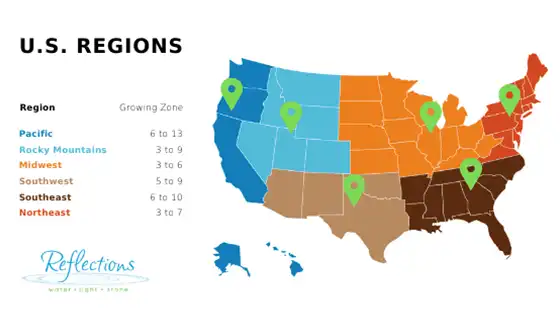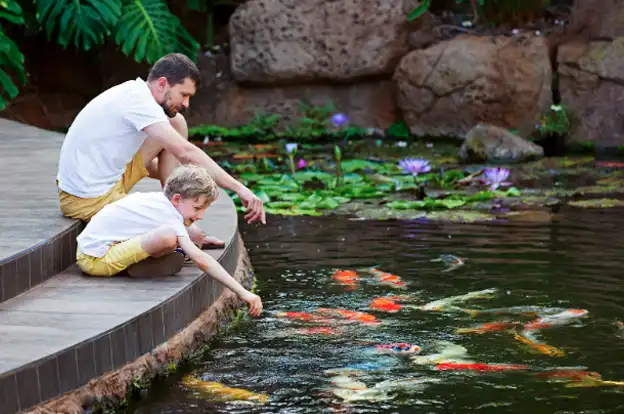Guide to Koi Ponds for Every Region of the US
March 9, 2020, 0 CommentsAdding a koi pond to your property’s landscape is an excellent way to transform your surroundings. Koi are low-maintenance, peaceful and beautiful outdoor pets, and the presence of a koi pond can add property value to your land. Elegant koi ponds also attract other wildlife and provide your backyard with a serene oasis.
There are many factors to consider when designing, installing and maintaining your backyard koi pond, but your region’s unique properties will play the biggest role when determining what is best for your pond. Although it is highly recommended that you consult with a water feature and landscape expert before beginning your project, we have created this guide to get you started and break down unique koi pond considerations by region.
Koi Fish Basics for Every Region
Koi fish are a colorful variety of Amur carp that were first bred in Japan for their unique colors and patterns in the early 1800’s. Known for their hardiness and tendency to grow quickly, Koi can live for more than 50 years and grow up to 4 feet long, depending on their habitat.
Due to their stand-out appearance, koi fish are susceptible to predators. Racoons, cats and birds from all regions of the US may find these fish to be an easy meal. It is recommended that your pond be at least 4 feet deep so that your fish have enough protection from curious creatures who may be waiting at your pond’s surface. Be sure to install your koi pond in a place where it can be seen and heard. Not only will this placement discourage predators from causing trouble, but it will help remind you to check on and care for your koi regularly.
Between plants and oxygen-demanding koi, it can be difficult to balance your pond’s oxygen levels. Koi also like to dig up plants and eat their roots, so it’s important to build a barrier (like a plant shelf) to discourage snacking while giving your koi access to oxygen. Water agitators, such as fountains, bubblers and waterfalls, can help add additional oxygen to your pond.
Like all fish, koi are at risk of parasites and infections. Be sure to provide your fish with clean, dechlorinated water, add anti-parasitic medications to your pond, and maintain your water’s overall quality with a solid filtration system. All of these, along with a maintained pH, will ensure that your koi remain happy and healthy.
Regional Considerations
Due to the varying terrain and climates throughout the US, your koi pond will look very different than ponds in other states:
Plants: Your pond should have a mix of surface, emergent, and submerged plants to provide oxygen, take care of excess nitrogen, and give shade and shelter to your koi. The USDA Hardiness Zone Map breaks North America down into 11 separate planting zones. Each zone is about 10°F colder or warmer than its adjacent zones. This map is especially helpful for determining which perennials will thrive and grow year after year in your region. Consult with a landscaper and water feature specialist for expert advice on which plants thrive in your area.
Water Temperatures: Koi are able to hibernate in cold climates and adjust to warm summers, but it’s crucial to protect them from the negatives of extreme climate changes. Low oxygen levels, freezing temperatures, and overactive algae can all harm your fish.
Sunlight: The intensity of sunlight in your region is also important to consider, as the sun can affect your pond’s lining, plants, and fish. When designing your koi pond, be sure to add leafy plants and shady structures so your fish can take refuge from the sun’s rays.
Koi Care by Region
What’s best for your koi and your water oasis? Find your region and read on for more area-specific tips:
Northeast
Hardiness Zones: 3-7
Plants to Consider: Hornwort, Elodea, American Water Lotus, Water Iris, Water Smartweed
Freezing Temperatures: Koi fish can last through cold winters if their home is designed well and cared for properly. Even though koi can survive in ponds that are 36 inches deep in milder climates, aim for a depth of at least 48 to 60 inches so that your koi can congregate comfortably at the bottom of the pond during the winter months. Koi will begin to hibernate and survive without food when temperatures drop below 40°-50°F; do not feed them until temperatures rise again in the spring, as any excess food in their digestive system can rot and make your fish ill. If your area is known to be especially frigid, you may consider moving your koi to an indoor tank for the winter or using a pond heater.
Precipitation: Hail, rain, and snow can bring the pollutants from the air into your pond, which can throw off the water’s pH levels. Remember to test the pond water after heavy precipitation and make adjustments as necessary.
Predators: In addition to predators like cats, foxes, raccoons, and heron, Northeastern koi pond owners in rural areas should be mindful of bears. Your local landscaper can provide you with more information on potential predators and tips on how to keep them away from your pond.

Midwest
Hardiness Zones: 3-6
Plants to Consider: Hardy Water Lilies, Hornwort, Elodea, Pickerelweed, American Water Lotus
Freezing Temperatures: Before the weather turns too cold in the fall, be sure to clean out the debris that built up in your pond over the summer months. This will minimize the buildup of gasses, like hydrogen sulfide, that are produced when pond debris breaks down, and will help keep your pond’s water tolerable for your fish. Consider covering your pond with leaf netting and using a skimmer during the fall to reduce pond cleanup. When freezing temperatures hit, it’s crucial to keep a portion of your pond ice free – this will allow gasses to exchange between the air and water. Stop feeding them altogether when they begin to hibernate (when temperatures drop below 40°-50°F) until the springtime. If winters are especially cold in your area, consider investing in a pond heater.
Pesticides and Fertilizers: If your property is anywhere near farmland, you have probably seen agrochemicals being sprayed onto crops. If introduced to your pond, these chemicals can disrupt your koi’s ecosystem. Avoid placing your koi pond anywhere near where these chemicals may be sprayed, and be sure to design your pond in a way that prevents runoff from entering the pond.
Southeast
Hardiness Zones: 6-10
Plants to Consider: Tropical Water Lilies, Water Hyacinth, Water Lettuce, Hornwort, Elodea, Pickerelweed, Water Clover
Overheating: Just like hot summer days can make us feel uncomfortable, your fish will feel the effects of rising temperatures. Warm water doesn’t hold as much oxygen, so you may notice your koi coming to the pond’s surface and “gasping” for air. Additionally, your pond will struggle with heavy evaporation rates and increased algae. Be extra mindful of your pond when water temperatures climb to 80°F or higher. Keep your koi cool and algae at bay by providing shade to your pond, changing your water frequently, adding pond netting or introducing a pond dye to the water. Make sure your pond water is circulating well with filters, aerators and other water features like fountains or bubblers. If conditions are still ripe for algae growth, cut back on feeding your koi too much protein; this encourages the koi to eat the algae instead and will reduce overall pond waste.
Precipitation: The pollution that is carried by heavy rainfalls can alter your pond’s pH level. Keep your koi healthy by monitoring the pH during your state’s rainy seasons and make adjustments when necessary.
Southwest
Hardiness Zones: 5-9
Plants to Consider: Water Hyacinth, Hornwort, Pickerelweed, Mosquito Fern, Water Clover, Sacred Lotus
Water Temperatures: Koi prefer cool water between 65 and 75°F, but these levels can be hard to maintain in the hottest months of the year. Warmer water holds less oxygen, which can also negatively impact your koi. Adequate shade, pond aeration systems, and changing your pond’s water frequently can help keep your koi’s home cool and oxygenated.
Heat and Sunlight: The Southwest sun can be intense for your koi, but it can also take a toll on rubber and plastic linings that you might use for the bottom of your pond. Consult with your landscaper before installing your lining to avoid deterioration problems later. Shade your pond with trees, leafy plants, waterlilies and umbrellas so your koi can stay cool when the sun is out. Evaporation will also occur at a higher rate during the summer, so remember to maintain your pond’s water levels with clean, dechlorinated water.
Desert Plant Debris: Unlike plants in cooler regions that shed their leaves annually in the fall, some desert plants can shed their leaves up to 5 times a year. Use a pond skimmer to remove debris and keep a hand-held net nearby for when additional cleaning is needed.
Rocky Mountains
Hardiness Zones: 3-9
Plants to Consider: Hornwort, Elodea, Pickerelweed, Water Clover, American Water Lotus
Avoid Runoff: Ideally, your pond should be positioned away from any uphill slopes to avoid dealing with runoff rainwater. This prevents grass clippings, soil and lawn chemicals from washing into your pond and affecting your koi population. If a slope is unavoidable, build a 3 inch ridge and dig a small ditch around your pond that can channel any runoff water away.
Predators: In addition to common koi predators like cats, raccoons and foxes, your pond may attract bears if you live in a rural area. Ask your landscaper about potential koi predators and for recommendations to keep them away from your pond.
Freezing Temperatures: Rocky Mountain winters shouldn’t be a problem for your koi if you plan ahead. Be sure to give your pond a thorough cleaning before temperatures drop, and plan on stopping your koi feedings when temperatures hit 40-50°F. Koi will hibernate when temperatures hit low temperatures, which means that feedings should stop until temperatures rise again in the spring. Keep a portion of the pond’s surface free of ice to maintain healthy oxygen levels. If your pond does accidentally freeze over, hot water can be used to melt a hole and a deicer can prevent future incidents. Never break the ice on your pond’s surface – the shockwaves from the force can hurt your dormant fish.
Pacific
Hardiness Zones: 6-13
Plants to Consider: Water Lettuce, Hornwort, Elodea, Pickerelweed, Mosquito Fern, Water Clover, Sacred Lotus
Heat and Sun: Depending on their exact location, koi owners throughout the Pacific region will have varying concerns about temperatures and sunlight. Southern Californians should be especially mindful of evaporation, direct sunlight, and higher temperatures in the summer. Shady leaves and umbrella-like barriers, frequent water changes, and aerators will keep their koi cool and healthy.
Precipitation: Being one of the wettest regions in the country during the October – March rainy season, Pacific Northwest rains can throw off the pH levels in your koi pond. Keep a sharp eye on your pond’s pH levels after heavy rainfalls and make adjustments with carbonates and bicarbonates when necessary; koi are healthiest and happiest when the pH level is between 7 and 8.6.
Conclusion
Building and maintaining a koi pond on your property can be incredibly rewarding, but pond features, needs, and challenges will vary greatly depending on your pond’s location. Many area-specific problems can be avoided with proper planning and construction, research, and guidance from koi pond and water garden experts.
Reflections Water Gardens proudly designs, renovates, cleans, and maintains water features and koi ponds. We work with the surrounding landscape and your property’s unique features to create a scenic and koi-friendly environment. We also consult with koi experts and carefully choose each component to ensure the health of your fish. Contact us today to learn more about our pond and water garden services.


0 Comments